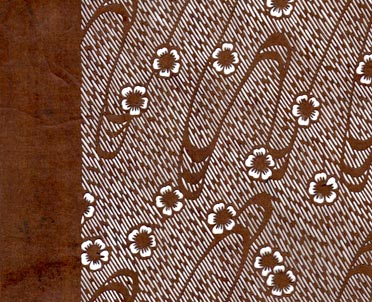LIAO COLLECTION ASIAN ANTIQUES
 KATAGAMI : Carved Paper, Art of the Japanese Stencil.One hundred paper textile stencils from Meiji-era (1868-1920) Japan. Katagami is "pattern paper", hand-carved mulberry paper used for katazome, the paste-resist process for dyeing fabric. The traditional craft of stencil cutting has been practiced since the eighth century; today katagami are prized for their exquisite craftsmanship and insight they provide into Japanese textile history and design.
KATAGAMI : Carved Paper, Art of the Japanese Stencil.One hundred paper textile stencils from Meiji-era (1868-1920) Japan. Katagami is "pattern paper", hand-carved mulberry paper used for katazome, the paste-resist process for dyeing fabric. The traditional craft of stencil cutting has been practiced since the eighth century; today katagami are prized for their exquisite craftsmanship and insight they provide into Japanese textile history and design.
Striking in their powerful graphic appeal, paper textile stencils were a medium for deeply held and ancient beliefs, incorporating folklore, religion, and daily custom into a universe of intricate animal and plant forms. Cranes, clouds, chrysanthemums, gourds and lichens, waves, carp, cherry and plum blossoms, bamboo and creeping vines are intertwined with a subtle geometry of checks, herringbone, dots, grids, stripes and spirals. Using highly specialized techniques and handmade tools, stencil cutters gracefully combined natural imagery with the most exuberant abstract patternmaking.
Made from the inner bark of the mulberry tree, the distinctive brown paper was integral to the success of the katazome. Sheets of paper were laminated with the sticky, tannin-rich juice of unripe persimmons, then cured and smoked, producing a rich brown color and moderately waterproof texture. Most stencils were reinforced by a net of fine silk thread in a delicate process called ito ire. Durable, supple and strong, the finished stencil could be reused up to 300 times.
The workmanship of katagami often seems beyond human ability. Using simple tools and methods, stencil cutters produced the most unforgiving of patterns. Unlike the textile industry of Europe's machine age, Japanese artisans relied on few labor-saving devices – where the West perfected its tools, the East sought to perfect the craftsman. In these stencils the viewer will find a sophistication both in technical mastery and decorative ingenuity that transcends ordinary definitions of industrial art.
Katagami : Carved Paper, Art of the Japanese Stencil was our Spring 2005 exhibit.